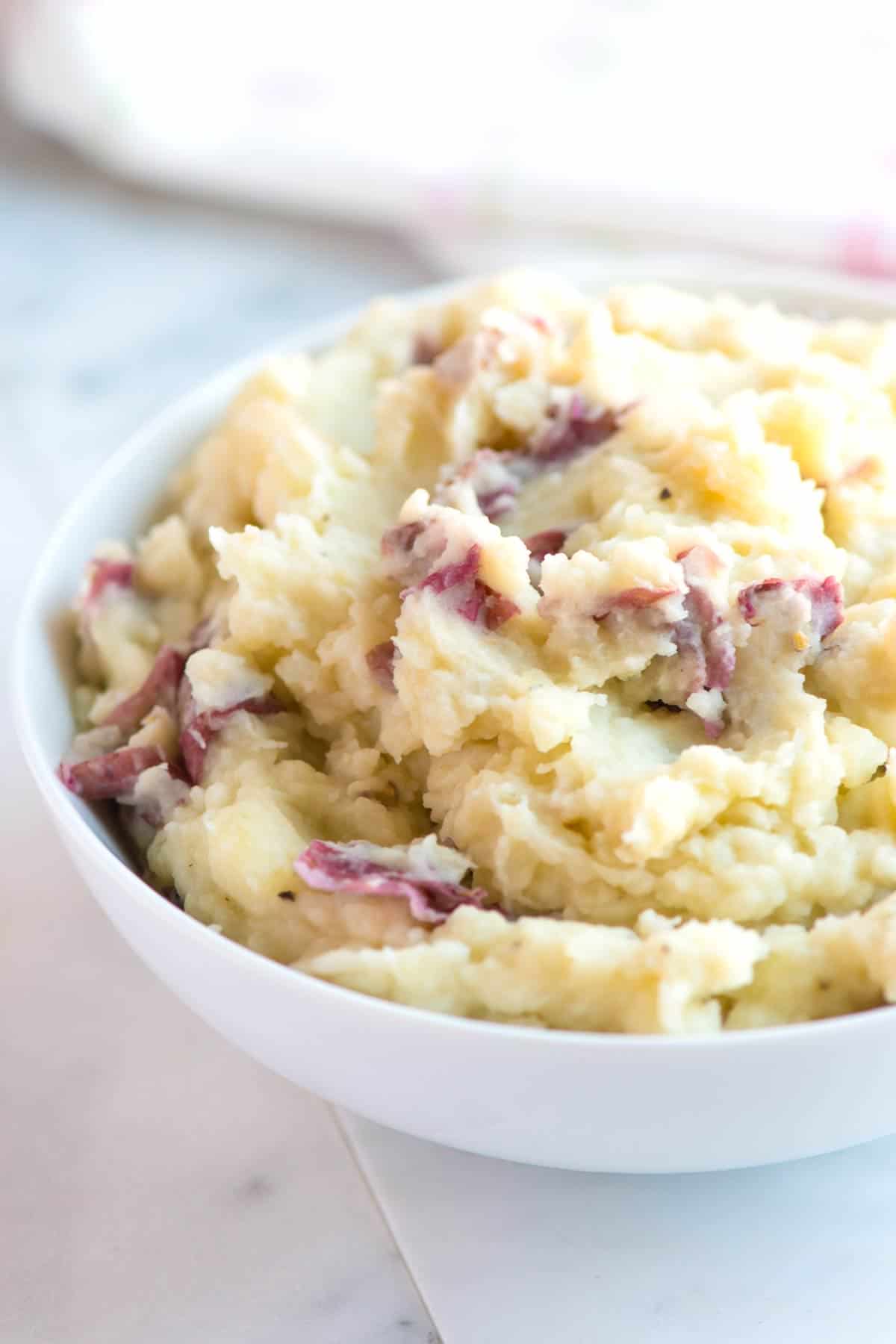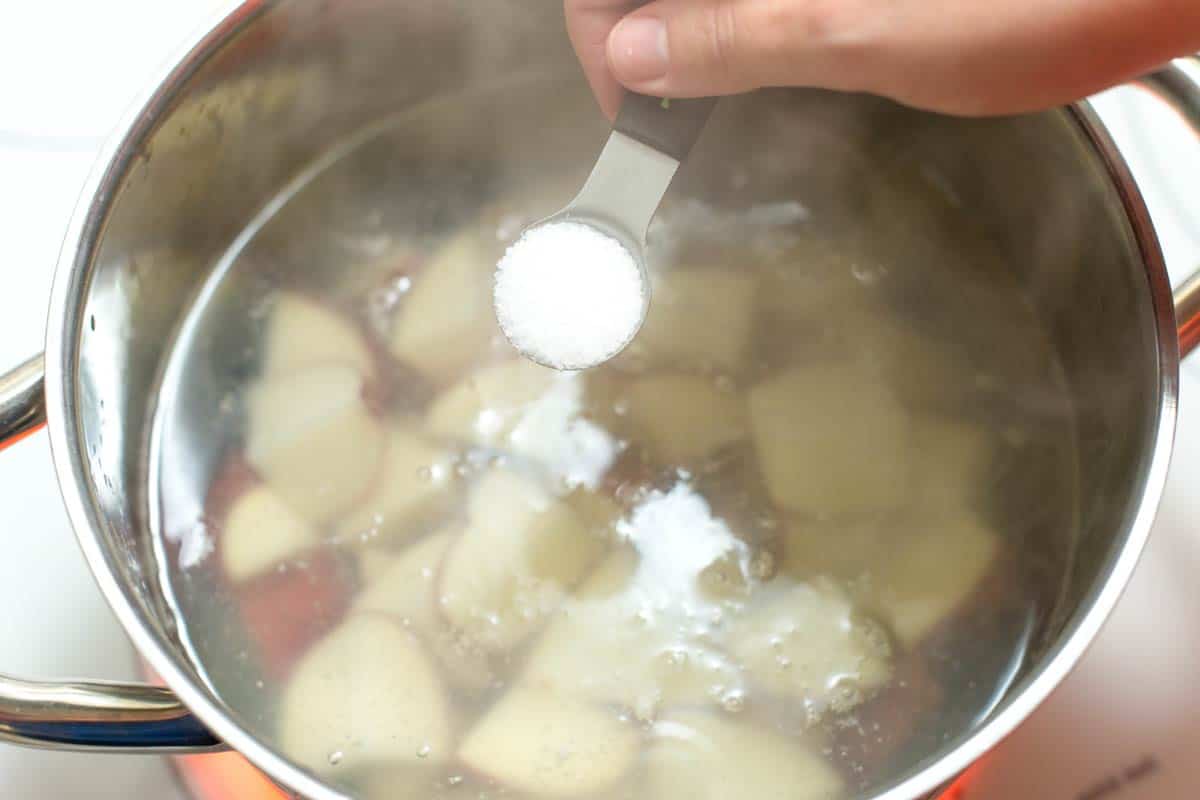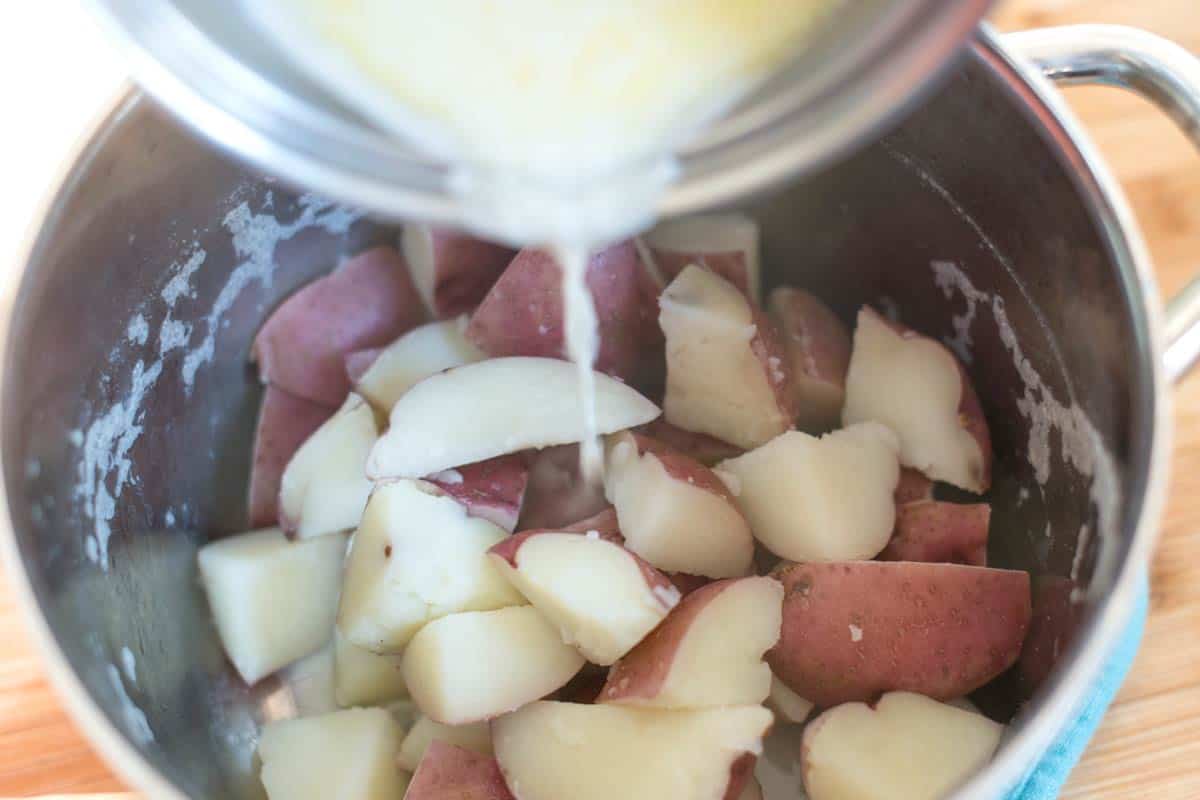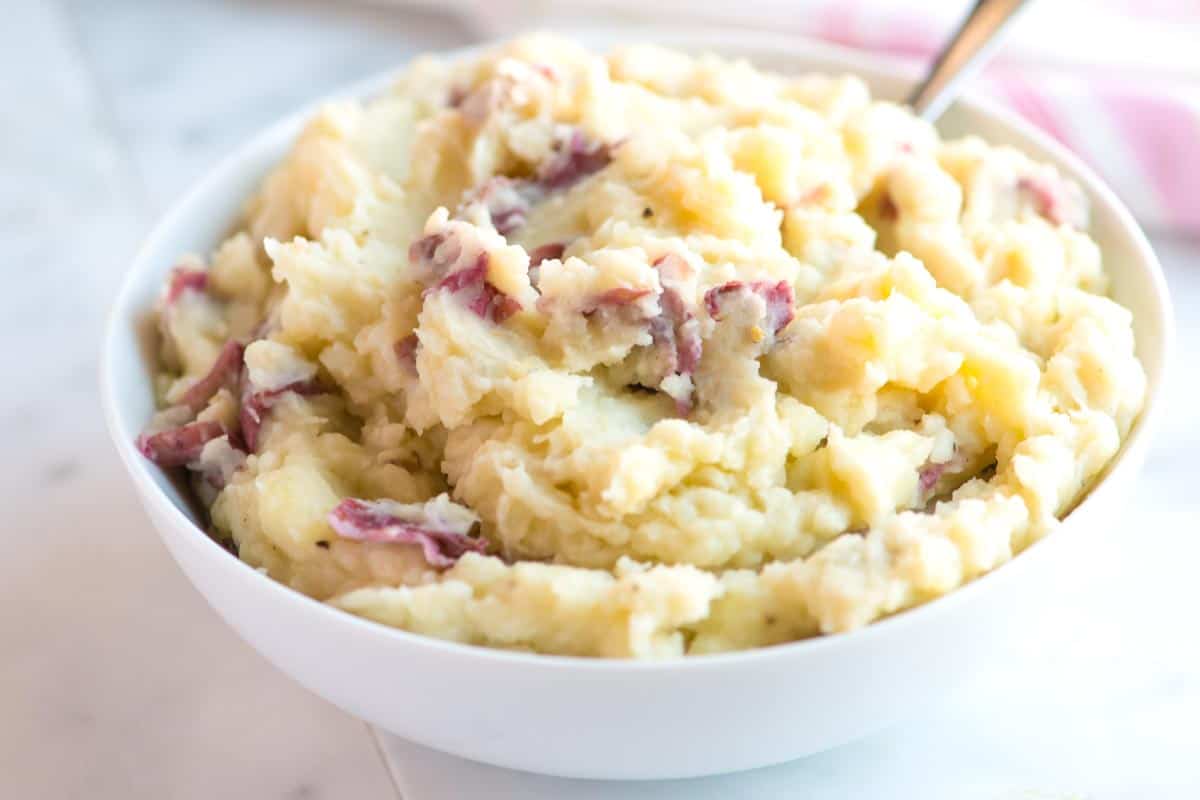Our favorite recipe for homemade mashed potatoes This works with potatoes in their skins and peeled potatoes. Learn which potatoes to use and how to prepare them so they’re creamy and delicious.
watch the video

Related: We love this creamy mashed sweet potato.
How to make the best mashed potatoes
We love mashed potatoes and make it often. Since we make a batch almost every week, we wanted to share our favorite way to prepare it. The recipe will vary slightly depending on who is preparing it. Adam likes to keep the potatoes unpeeled, and I usually peel them. Sometimes we use milk, sometimes we add a dash of broth (vegetable or chicken broth). And if we feel like it, we add a spoonful of sour cream or a splash of cream.

While you can think of it as an everyday recipe that you can adapt depending on what you have in the fridge (or whoever is making it), it’s also perfect for entertaining or holiday meals. (For Thanksgiving, we always make a batch of these potatoes, our really good mushroom filling, and those buttery whole fried onions.)
Which potatoes are best?
I use thin-skinned potatoes like Creamer (or baby potatoes) or Yukon Gold. Small yellow, white or red potatoes are perfect. They’re quick to make and make the best mashed potatoes in their skins! Since we’re usually short on time, we can skip peeling the smaller potatoes and just halve or quarter them. (We’re using the same types of potatoes for this Crispy Baked Potatoes recipe!)
They are also creamier than starchier potatoes, such as B. russet potatoes. So if you love creamy mashed potatoes, opt for one of the small, thin-skinned varieties.
If you love fluffy mashed potatoesuse starchy potatoes (like Russet or Idaho) or for a combination of fluffy and creamy, use both waxy potatoes (like Red Bliss or baby potatoes) and starchy potatoes.
Adam and I talk back and forth to peel the potatoes. Adam loves to leave the potatoes on and I prefer the potatoes to be peeled. It’s safe to say that whether they are peeled or not depends on who makes our potatoes.
Our top tips for making mashed potatoes
Adam and I might disagree when it comes to peeling the potatoes, but we don’t disagree when it comes to cooking. Here are our top tips for preparing in your kitchen:
Cut the potatoes into a similar size. You want the potatoes to cook evenly, and keeping the potatoes a similar size helps with this. I cut mine into medium (1 to 2 inch) pieces. At this size, the potatoes will take about 15 minutes to cook.
Salt the cooking water. Whatever potato you choose to cook, don’t forget the salt. A tablespoon of salt should suffice. Just like adding salt to the pasta water, the salt water flavors the potatoes. They don’t taste salty, just like great potatoes.

Let simmer until soft. If I can easily pierce a potato with a fork, they’re done. Prolonged cooking will cause the potatoes to overcook, making them sticky.
Drain them well. Once the potatoes are done, I drain them, put them back in the pot and cover them with a clean tea towel for about five minutes. This will help the potatoes absorb excess steam, which can make the mashed potatoes watery. Another option is to invert the cooked potatoes onto a baking sheet and set aside for 5 minutes.
Add warm butter and milk or broth. We add some liquid and melted butter to make the potatoes extra creamy. For the liquid, we usually add equal parts milk and chicken broth. You can add whole milk or chicken broth. You can even add a dash or two of heavy cream to the potatoes to really cream them up. Warm liquid absorbs better than cold and keeps the mashed potatoes nice and hot.
We’re sticking with 1 cup of liquid for 2 pounds of cooked potatoes. For thicker mashed potatoes, reduce the amount of liquid from 1 cup to 3/4 cup.

hand pulp. Most of the time we use our handy potato masher, but for extra creamy potatoes we use a food grinder. Pass the cooked potatoes through the smallest wheel of a food mill, then stir in the milk or chicken broth and butter. (It is best to peel the potatoes for this). I don’t recommend using a food processor and if using an immersion blender, be careful not to over-beat the potatoes as over-mixing will make the mashed potatoes sticky and sticky.
Make them extra creamy. When I want ultra-creamy mashed potatoes, I add a dollop of sour cream. The spiciness of the sour cream weakens the richness of the butter and makes the potatoes so creamy.
Add additional flavors. You can add various additional ingredients to the mashed potatoes. Try garlic (fresh or roasted garlic), fresh herbs, chives, scallions, cream cheese, shredded cheese, and even cooked and crumbled bacon.
What to serve with mashed potatoes
I can practically eat this mashed potato with nothing else on the plate. However, there are so many ways to serve them:

More easy potato recipes
Recipe updated, originally posted November 2013. Since posting in 2013 we have tweaked the recipe to make it clearer. – Adam and Joanne
Our favorite homemade mashed potatoes
-
PREPARATION
-
COOK
-
IN TOTAL
Our favorite way to make mashed potatoes. Think of this as an everyday recipe—one that you can adapt based on what you have in the fridge. We recommend adding 1 cup of liquid to the potatoes. At home, we usually use equal parts milk and chicken broth. You can use whole milk or whole broth (chicken or vegetable). Or substitute cream or sour cream for some milk for extra decadent potatoes. A tablespoon or two of cream cheese wouldn’t hurt either.
The trick to great mashed potatoes is to season them beforehand. Add a generous amount of salt to the water to flavor the potatoes while they cook – we use at least 1 tablespoon. This is similar to salting pasta water.
Makes about 6 servings
Watch as we prepare the recipe
directions
- Prepare potatoes
1Scrub the potatoes and then dice them. Make sure they are a similar size. (We often leave the skin on the potatoes, but that’s entirely up to you.)
2Place the potatoes in a large saucepan, add a tablespoon of salt and cover with water. Bring to a boil over medium-high heat, then simmer on low. Cook until potatoes fall apart when pierced with a fork, 15 to 20 minutes.
- End
1Heat the milk or chicken broth and butter until warm and the butter has melted. Drain the potatoes, then return them to the pot and cover with a clean tea towel. Let them sit for about 5 minutes to absorb any excess steam that can make the mashed potatoes watery.
2Add the warm butter mixture and puree the potatoes until creamy. (Don’t worry if the potatoes seem a little thin at first, they’ll absorb the liquid after a minute or two.) Stir in the pepper and a dollop of heavy cream or sour cream (if using).
3Taste and season with additional salt and pepper. Let rest 5 minutes for potatoes to thicken, then serve.
Adam and Joanne’s tips
- You can use rust red (baked) potatoes. The mashed potatoes will be a little fluffier.
- For firmer mashed potatoes, reduce the amount of liquid listed in the recipe from 1 cup to 3/4 cup.
- For extra creamy potatoes, use a food grinder. Pass the boiled potatoes through the smallest wheel of a food mill, then stir in the milk or chicken broth and butter. (It is best to peel the potatoes for this).
- Nutritional Information: The nutritional information below is an estimate. We used the USDA database to calculate approximate values. We didn’t add salt because you have to add it according to taste. We went from 1/2 milk to 1/2 broth and added a dollop of heavy cream.
If you make this recipe, take a picture and tag it with the hashtag #inspiredtaste – we love to see your creations on Instagram and Facebook! Find us: @inspiredtaste
Nutritional value per serving
calories
182
/
protein
4g
/
carbohydrate
28g
/
fiber
3g
/
total sugar
2g
/
total fat
7g
/
Saturated Fatty Acids
4g
/
cholesterol
18 mg

